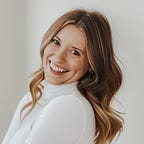Interview with Sanette Tanaka Sloan, UX Designer at Google News
Sanette grew up in the Chicago suburbs and is a proud hapa (half Japanese). She has a BA in Public Policy and History from Duke University and a MSc in Creative Digital Media, with an Interaction Design concentration, from the Dublin Institute of Technology.
Sanette started her career as a real-estate reporter at The Wall Street Journal and after a few years, she decided to switch into design. She worked as a senior product designer at Vox Media and currently works at Google News in NYC. Sanette lives in New York with her husband Alex.
You can follow Sanette on Twitter, Medium, and LinkedIn.
If you have any questions relating to this interview or are interested in being interviewed, feel free to DM me on Instagram or reach out on LinkedIn.
How did you get into design/research and UX?
After about a year of working as a reporter, I realized that my interests and curiosities — particularly around how our audience was understanding and engaging with our work — were more aligned with product thinking and not strictly in reporting. I started to teach myself more about design and UX, and eventually decided that I wanted to learn in a more structured way. That’s what prompted me to go to graduate school and pursue UX full time.
Do you have a design philosophy?
This is less of a philosophy and more of a mantra. Design is a practice, so the best thing you can do is just start.
What UX skills are useful, but not taught in school?
Assuming you’re working within a team, you really have to nail the soft skills. In school, you’re shielded from many of the realities that come with working at a company, like cultural clashes, office politics, and tricky personalities. Learning how to navigate those waters is absolutely crucial to be successful as a designer.
What do you think makes a great designer or UX researcher?
Genuine interest in and empathy for other people
What do you think makes a bad designer or UX researcher?
A poor listener
What does a typical workday look like for you?
I wake up around 7 or so and snooze a few times (trying to break that habit though!).I try to do something for myself in the mornings — either journaling, going for a run, or talking with my husband over coffee. My work days are a mix of meetings, connecting with various people on my team, and hopefully some heads-down work designing concepts and solutions. After work, I like to cook dinner or go out, and usually wind down with a TV show before bed.
What challenges do you face when collaborating with cross functional partners like PMs & engineers?
Designers often have to strike the balance between pragmatic and visionary. I’ve found that visionary work in particular can be a hard sell for some PMs and engineers since it can seem so far removed from the present.
How do you see UX evolving in the future?
I hope and believe UX will become more diverse in terms of its makeup and inclusive in terms of its users.
What are the most common mistakes you see in UX portfolios?
Many UX case studies are a lovely step-by-step walkthrough of an ideal path for a target user, but solutions aren’t usually that tidy. Show the messy. Show what you wished you could have done, but weren’t able to. Reflect deeply on your process.
What’s your biggest design pet peeve?
When research and data overrides common sense
Do you have any tips for anyone looking to get into the UX field?
I really empathize with this question because first getting my foot in the door was a long, challenging path for me.
When I was first starting out, I couldn’t think of a single person in my network who was a designer. I tried to be creative and scoured LinkedIn for any connection (or second connection) who had the words “designer” or “product” in their title and reached out to them. I asked them how they got into design, and which books, resources, and people they recommended. Then I pursued those books, resources, and people. I basically tried to acquaint myself with the industry so I could figure out the best path for me.
What are the most important things when pitching your design work?
I believe pitching is just as important as actually doing the work, so I put a lot of thought into crafting my narrative and framing my designs. I try to draw a crystal clear connection between the problem I’m solving and why my solution is the best approach. I use storytelling to help my audience follow my train of thought. And I practice. A lot.
Do you have any side projects you’re working on?
Right now, I’m designing various things for my friends. Right now I’m working on t-shirts for a race, a food tour map for a bachelorette, and a brand/UX refresh for my former college newspaper site.
What traits do you think the best leaders have?
A desire to support and uplift their team
What do you think are the biggest gaps in UX education space?
I want students in high school and college to know that UX is a viable, possible career for them. Some schools that are more tech or design-oriented do this well, but many just aren’t part of the pipeline.
What do you do to improve your design skills?
I try to surround myself with incredible thinkers. I appreciate working at Google because I’m exposed to so many thoughtful, talented people. I learn just by being around them.
What non-ux skills are helpful as a UX designer in a big designer in a big company?
Being able to communicate well with people in different job functions.
